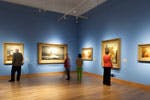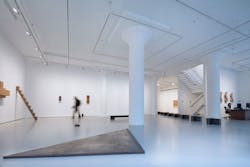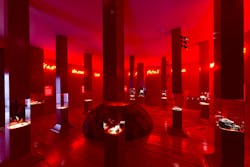Artists conceive their pictorial works objectively but frequently show them in a very subjective way – and galleries and museums display their specific exhibitions with corresponding diversity. Not only do the arrangement of exhibits and the nature of the exhibition architecture contribute to creating either a neutral or theatrical effect, but the illumination of works of art also plays a significant role. Lighting must also comply with conservational and energy-related requirements. This article explains the relevance of specific design and technical aspects for the various methods of presentation.
Light generates highly different atmospheres in exhibition spaces. Skylights in traditional studios provide soft, diffuse light for a neutral ambience throughout the day, whereas electric lighting with wallwashing creates a comparatively calm and sober character. This also creates ideal surroundings for providing an objective impression of the works of art. For a long time many museums worked with this principle of daylight or with diffuse skylights or light ceilings, although a sense of monotony may be created in the spaces themselves and when observing art because of this low-contrast method of display. Historical museums in particular compensated for this uniformity by either subtly or intensively varying the saturation and brightness of wall colors across the individual exhibition rooms. A similar effect of contrast can also be achieved with lighting. Curators are able to determine whether an objective mood or more dramatic ambience characterizes the exhibition space by specifying the ratio of diffuse general lighting to directed accent lighting. They can also implement individual lighting concepts for successive exhibitions with minimum complexity by using a flexible infrastructure consisting of tracks, in combination with spotlights featuring interchangeable lenses, for various light distributions and convenient dimming functionality. Efficient LED lighting technology helps to save energy in this regard and at the same time implement sophisticated lighting solutions that integrate aspects of conservation.
Bright, homogeneous light for neutral displays of art
If an exhibition focuses on a wide range of exhibits or aims to achieve a contemplative mood, lighting should be used to underline this atmosphere and attain a neutral approach. Because artists frequently work with functional, diffuse lighting in their studios, they consequently aim for such lighting conditions in exhibitions. Furthermore, the modern era has put an end to the opulently embellished gallery rooms of the nineteenth century to now present art in sober, empty spaces. The art critic Brian O’Doherty summarized this development in his influential publication "Inside the White Cube: The Ideology of the Gallery Space" (1976). For the artists of the Color Field movement these empty, objective rooms provided an ideal backdrop for their art. As a consequence, part of the responsibility of a lighting designer is to capture this approach via lighting, as explained by the lighting designer Scott Rosenfeld who worked on the "Color Field Gallery" in the Smithsonian American Art Museum in Washington. "Our objective when lighting our modern galleries, especially the one dedicated to Color Field painting, is to help artworks to appear as a natural extension of the white wall. The lighting should subtly 'pop' works off the wall without making them look 'spot lit'. If the relationship between the wall and the work is perfect, it will appear almost to float on the wall." This of course represents a significant break with history, as Rosenfeld continues to explain. "This is opposite from the way we light installations in our nineteenth century galleries where paintings are hung on deeply colored walls."
As a result, the uniform distribution of brightness on vertical surfaces achieves a soft, harmonious atmosphere that allows the works of art to become a single unit with the wall. This neutral ambience is especially advantageous with large-scale artworks. While observing the art, a calm and generously-dimensioned impression of the space is achieved. Wallwashers are predestined for this method of lighting because they feature a special light distribution that achieves the necessarily high level of uniformity in the vertical and horizontal planes. If however an exhibition should not have a neutral appearance but should emphasize individual artworks, accent lighting represents the theatrical opposite.
Rich-contrast displays with light for dramatic effects
With regard to the mass of images available during everyday life and in museums in particular, curators are faced with the challenge of focusing attention on individual works of art. In the movie industry, Hollywood uses intensive accent lighting to present film stars at festivals on red carpets, or for strikingly emphasizing actors in movies by using intensive bright-dark contrasts.
If during exhibitions the space itself visually takes a step back, exhibits are automatically placed in the foreground, thereby enabling observers to concentrate more effectively on the works of art. Dark colored walls in historical museums have also achieved this effect to create a subtle impression of depth that directs attention more strongly to the art, but because bright, white walls tend to dominate modern exhibition rooms in our times, this method of design has been completely neglected by many galleries. Despite this, individual works of art can be significantly emphasized and the above-described depth effect achieved if a spotlight generates a contrast in brightness to the surroundings with a distinctly accentuated cone of light. This then places the brightly illuminated picture in the foreground while the wall plane adopts only secondary importance. Accent lighting can also establish hierarchies in perception by using different illuminance levels, in turn enabling curators to connect between works of art and the exhibition within a space, or else structure a sequence of rooms.
Many exhibitions already feature high-contrast, bright-dark scenarios with their image content, for example with black and white photography if the photographer dramatically designs portraits using the antitheses of light and shadow. In such cases a special sense of magic can be created with accent lighting because the atmosphere in the exhibition references the mood in the pictures. If the light cone is precisely limited to the image formats of the exhibits using projection spotlights, a special fascination also comes about because the works of art appear to illuminate from within.
High-contrast presentations with light can even be increased in terms of theatrical impact if the images are not continuously bathed in light in exhibitions, but if dynamic light is used. Peggy Guggenheim used dynamic light in her first New York gallery "The Art of This Century" in around 1940 with the intention of creating a new form of access to art, and visually communicating the pulsating character of life by using pulsating light. However, if such dynamic displays with accent lighting were to be continuously used they would soon appear shallow and boring, and for this reason a variable infrastructure for lighting is essential.
Flexibly responding to changing presentations
Because curators and exhibition organizers approach museums with exceedingly different lighting needs, responses often quickly result in technically complex lighting solutions. Not only do works of art themselves require different forms of lighting because of their size, but artists as well as in-house or external curators also need to express a variety of desires about how to use light in exhibitions to optimum effect. Furthermore, the repositioning of exhibition walls may demand the spatial rearrangement of luminaires.
Permanently installed luminaire systems covering only one lighting requirement such as the narrow accenting of small exhibits, the bathing of large artworks with light or wallwashing for pictures do not qualify due to economic aspects. Hardly any museum has the funds to maintain a wide selection of alternative luminaires for all their spaces, and for this reason the solution is found in a flexible and simple to handle strategy. As a result, a flexible infrastructure consisting of tracks, spotlights and interchangeable lenses is initially required to respond appropriately to new exhibits if the exhibition is changed. Tracks are predestined for this purpose because their luminaires can be replaced without effort, and they can also be used in exhibitions for the power supply of exhibits via adapters or for the mechanical suspension of objects. The second level of flexibility is found in easily aligned spotlights that can be adjusted precisely according to the individual artworks – for example with the classic tilt angle of 30° for harmonious modeling with light and shadow, or with a steep light incidence direction that creates dramatic grazing light to emphasize textures with hard shadowing.
The third and very decisive level of flexibility is the variability of light distributions, ranging from expressive accenting to the sober appearance of wallwashing. Interchangeable Spherolit lenses provide curators with a high degree of design flexibility when selecting a lighting concept as well as in terms of temporary modifications. The lens positioned in front of the spotlight determines the luminaire's light distribution characteristic by the shape of the Spherolits. The diversity of light distribution patterns ranges from rotationally symmetrical distributions from very narrow with less than 10° to wide flooding in excess of 80°, as well as axially symmetrical light distributions for oval light cones to asymmetrical for uniform wallwashing. The Spherolit lenses can be conveniently exchanged without tools on the luminaire head to quickly and simply create another light distribution.
On the electronic side, dimmability is an indispensable factor for flexibility that enables the lighting level to be modified according to the needs of sensitive exhibits – either via the light control system or directly on the spotlight, or via a combination of these. Despite aiming for maximum flexibility, a sense of consistency in several aspects is also mandatory for the quality of light. Color temperature and color rendering should be constant across different product families in order to exclude color variations within associated rooms or when retroactively supplementing the lighting installation with further luminaires. The key to flexibility is therefore found in a simple and modular luminaire system offering design flexibility and planning safety, and thereby also contributing to the cost efficiency of the technical museum infrastructure.
Coordinating the display of art and protecting exhibits
The opulent presentation of art in spaces flooded with light or emphasized with dramatic accenting may be tempting for attracting high numbers of visitors and various sponsors, in turn achieving an economically successful exhibition, but this strategy has negative consequences with sensitive exhibits. Irreversible photochemical reactions and effects caused by heat radiation endanger the long-term display of such objects. The most obvious effect is loss of color when high levels of UV radiation cause colors to fade, thus diminishing the impact of an artwork. Because of the high component of ultraviolet radiation in daylight, the intelligent handling of glazed windows and fenestrated roofs is essential. However, exhibits are also exposed to UV loads from electrical lighting, although with modern warm white LEDs the damage factor is fortunately less than with low voltage halogen lamps with UV filters. With the progression from thermal radiators such as halogen lamps to LED technology, conservators gain a further important advantage – the problem of infrared no longer applies because white LEDs no longer emit this radiation, in contrast to their predecessors.
Lighting recommendations for galleries and museums
- When designing exhibitions, the curatorial decision for a particular exhibition concept determines the code of practice for the lighting concept. The spectrum ranges from uniform illumination to rich-contrast displays with accent lighting and dynamic sequences of light. Communicate the theme of your exhibition with light!
- Ensuring flexibility: An adaptive infrastructure with tracks is recommended to respond in the long term to changing types of art and presentation. Exchangeable optics for differing beam angles, dimmability of the light source and flexible light control all guarantee optimum lighting conditions for museums, both now and in the future.
- Integrating conservational aspects: Conservational requirements for protecting works of art are opposed to the needs of observers concerning sufficient brightness. The damaging light spectra found in artificial light and daylight must be avoided if possible to protect the exhibits. Dimmable, warm white LED lighting today provides the optimum solution for sensitive artworks.
- Benefiting from efficiency: Economical lighting technology cuts operating overheads to create financial flexibility that in turn enables investments in displays and collections. High luminous efficacy, high luminaire light output ratios and long lifespans have positive effects on operating costs.
- Working with good visual comfort: Luminaires with good glare control and intelligent luminaire arrangements aid presentations with light. Direct glare as well as indirect glare caused by glass surfaces can be also minimized in this way to promote the unlimited enjoyment of art.
Art galleries with white walls and homogeneous wallwashing aim for prosaic overall presentations to avoid influencing the interpretation of artworks due to strong lighting. Fergus McGaeffrey Gallery, NYC, Richard Nonas exhibition; New York, USA. Image: © ERCO GmbH, www.erco.com, photography: Edgar Zippel
Accenting of the individual photographs releases them from their spatial context and places the architecture in the background. "Industrious" exhibition, Kunstmuseum Bern. Image: © ERCO GmbH, www.erco.com, photography: Howard Brundrett
The intensive color creates a dramatic atmosphere for visitors and transforms the display into an impressive experience. Museum für Urgeschichte MAMUZ, Mistelbach. Exhibition architecture: Atelier Christoph Cremer, Vienna. Image: © ERCO GmbH, www.erco.com, photography: Gustavo Allidi Bernasconi.
About ERCO
The ERCO Light Factory in the German town of Lüdenscheid is a leading international specialist in architectural lighting using LED technology. The family business, founded in 1934, now operates as a global player with independent sales organizations and partners in 55 countries worldwide. Since 2015 ERCO’s portfolio has been 100% LED. With this in mind, ERCO in Lüdenscheid develops, designs and produces digital luminaires with focus on photometrics, electronics and design. Working closely with architects, lighting designers and engineers, ERCO develops lighting tools used primarily for applications in the following fields: Work, Shop, Culture, Community, Hospitality, Living, Public and Contemplation. ERCO understands digital light as the fourth dimension of architecture – providing highly precise and efficient lighting solutions to support creative designers in turning their visions into reality.






